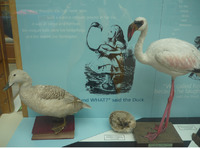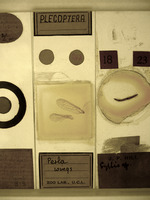Items
Site
The Medicine Chest
keywords is exactly
research trip
-

Pisces (Platichthys Fleus)
Addressing the fact that 95% of known animal species are smaller than our thumbs, yet natural history museums displays are filled with mostly large animals, this sub-museum shows the legs of a flea highlighting its muscles; a whole squid, just a couple of millimetres long; beetles that have been sliced along their entire length, through the antennae, head, legs and body — 1/10th of a millimetre thick; as well as these two baby flounder fish. -

Observing marbling in Edirne
A marbling demonstration observed during a 2012 trip to Istanbul and a visit to the neighbouring Edirne's Health Museum. Opened in Sultan Bayezid II külliye in 1488, the hospital treated patients for over 400 years, until 1909, along the tradition of Turkish-Islamic medicine, which included the treatment of diseases by music. -

Museum of Natural History Oxford
On a sunny afternoon, July 4th 1862, an Oxford don took out four friends, for a rowing expedition up the Thames. The don was the Oxford mathematician, photographer and storyteller, Charles Dodgeson (better known by his pen name, Lewis Carroll) and his friends were the Rev. Robinson Duckworth and three children – Alice Liddell, aged 10, and her sisters. During the afternoon Dodgeson spun out a series of fantastic yarns incorporating friends and familiar places in Oxford, mathematical riddles, literary allusions and countless references to natural history. -

Tabloid
"The brand name ‘Tabloid’, however, stayed associated with things ‘reduced in size or compressed’ (Larson 2009: 86). It is this reduction in size that made the firm’s drugs perfect for travel, and the medicine chests in particular were designed to this end" (Liebenberg 2021: 45). -

Perla Wings
Addressing the fact that 95% of known animal species are smaller than our thumbs, yet natural history museums displays are filled with mostly large animals, this sub-museum shows the legs of a flea highlighting its muscles; a whole squid, just a couple of millimetres long; beetles that have been sliced along their entire length, through the antennae, head, legs and body – 1/10th of a millimetre thick; as well as the wings of a Chrysopa perla, a fearsome predator in the insect world.


